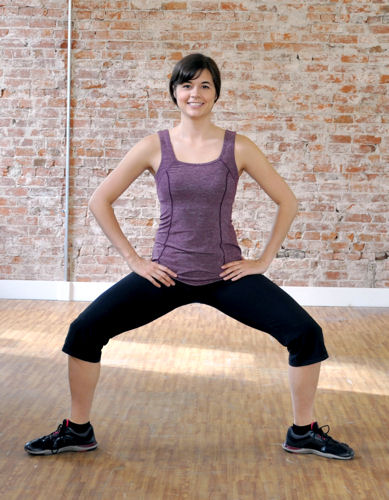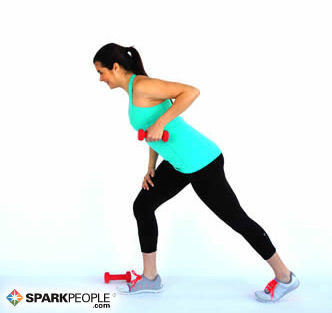|
What’s the best way to stay in shape during your pregnancy—and beyond? Get in the best shape of your life before you get pregnant! Here are my top six exercise recommendations for preparing your body for a strong and healthy pregnancy and postpartum recovery.  1. Plié Squats 1. Plié SquatsWhy: Squats are probably hands down the best overall exercise you can learn to do correctly. Learning to do a proper squat can save you from future back, hip and knee pain, all of which can also occur during pregnancy. In a plié (sumo) squat, you rotate out from the hips and use your inner thighs more than in a traditional squat. This is important during pregnancy because eventually, when your bump is big enough, it will be more comfortable to rotate out from the hips. (Plus, you need your hips to open up more for labor.) So why not get a head start and become strong and comfortable in this position now? Squats build strength in your entire lower body. When you are pregnant you need your legs more than ever to help support your increased bodyweight. How: Stand with your legs a little wider than shoulder distance apart and rotate out from the hips so that your thighs, knees and feet are turned out. When you squat, think of keeping your shoulders and hips stacked. Try not to collapse at the bottom of the squat. Aim for 25 plié squats three times a week. On the last 5 reps, hold the squat position a little longer to get a deeper stretch in the hips and inner thighs.  2. Plank 2. PlankWhy: You want your core to be the strongest it possibly can be going into pregnancy. Obviously, pregnancy affects this area of the body more than others, and it's often the hardest to bounce back after baby arrives. The best way to counter these challenges is build a strong core prior to your pregnancy so you can bounce back to more easily afterwards. At a certain point in your pregnancy, crunches and twisting are no longer comfortable or effective at training your abs. Lying on your back for extended periods of time should also be avoided later in pregnancy. I have women ask me all the time about diastasis recti - how to avoid it and how to fix it. The best way to avoid it is to get your core as strong as it possibly can be prior to pregnancy (however sometimes it’s out of your control). If you really want to dig deep and hit the transverse abdominals, you are going to need an exercise that goes deep. Plank is your answer! The great news is if you get good at it now you can do it throughout your pregnancy as well! Prior to getting pregnant I was able to hold a plank upwards of four minutes and up until the last few weeks of my pregnancy I was still able to hold a one-minute plank! This exercise not only works your abdominals but your entire core—even your arms and shoulders. How: Begin on all fours with your hands in line with your shoulders and your knees in line with your hips. Keep your elbows slightly bent so that your muscles (not your bones) are working to hold your body up. Begin by walking your knees a little farther back so that your body is on an incline. Squeeze your butt, your abs and your shoulder blades together as you hold. You want to make sure you have a nice flat back that does not sink. You may need to think of pushing your back up against the ceiling. Once you’ve accomplished this position, lift your knees up off the floor and hold. A plank a day keeps the stretch marks away! OK that might not be entirely true, but you should work on holding a plank as long as you can each day. Start with 15 seconds today and add on 5 seconds each week! You’ll be up to one minute—or more—in no time!  3. Rows 3. RowsWhy: During pregnancy, your breasts will get larger and heavier along with your belly. This can round your shoulders forward, tighten your chest muscles, and lead to back pain. Your back muscles are the ones countering all the extra weight. The best way to avoid back pain during pregnancy is to strengthen it prior to becoming pregnant. How: Stand with your feet in a split lunge, lengthening your right leg out behind you with the heel down in back. This is your base of support. With your hips and shoulders square to the floor, hold a free weight in the same hand as leg that is back. “Row” the arm back to the hip, bending at the elbow and squeezing the shoulder blade towards the middle of the back. Release the arm back out long in front of you. For a greater challenge (and to attack the glutes and hamstring more) lift the back leg up off the floor. Feel a little unsteady or already pregnant? Take the feet wide and even, about shoulder width apart.) Make sure to repeat on the other side. Try 3 sets of 10-12 rows on each side, 2-3 times a week. Gradually increase the weight you lift as you become stronger.  4. Push-Ups 4. Push-UpsWhy: Push-ups go hand in hand with rows, and they only become harder and more limiting as pregnancy progresses. (You’ll have to do them on an incline, such as with your hands on a bench, when your belly gets too large to do them on the floor.) Just as you want to keep your back strong to help counter your growing front, you also want to keep the muscles strong around your growing front. Push-ups not only attack the pectorals (chest muscles), but they will also help strengthen the shoulders, which you need to keep strong in preparation for picking up the growing baby that will soon be by your side. If you can push up your own body weight, you will have no problem lifting or carrying your own child. Besides, I think every woman in every stage of life should be able to do at least 10 solid push-ups. To be able to push up your own body weight not only might be a necessity someday, but is so empowering and sexy! No doubt, once you do become pregnant and heavier, this exercise will become increasingly difficult, so get yourself together ahead of time and practice those push-ups now. How: A great place to start your push-up is from a plank position (see plank exercise description) on your knees or toes. You may need to take your hands a little wider than shoulder distance apart. Lower your entire body down as one unit, keeping the head in line with the rest of your body. An ideal position is where the shoulder and elbow hit a 90 degree angle. With just as much control, take a deep exhale through the mouth and bring your body all the way on up. Work toward 3 sets of 10 push-ups on your toes (or 20 on your knees) 2-3 times a week.  5. Triceps Dips 5. Triceps DipsWhy: Did you know that women we carry a good amount of estrogen in our triceps? Research shows that too much estrogen or an imbalance in estrogen can cause excess fat storage. Guess what hormone you have more of during pregnancy? Yes, estrogen. This means that more than likely, no matter what you do during pregnancy, your triceps will carry more fat than before. Therefore, the only thing we can do to make this situation a little bit better is to tone and strengthen them prior to pregnancy. This way, when you are no longer pregnant and/or nursing, your triceps will hopefully return to their previous toned state. Plus, have you ever seen a pregnant woman struggle to push herself up out of chair? You don’t want to be in that position! So get a head start in strengthening those triceps with dips that will help in elevating you up and onwards. How: Elevate your upper body on a box, chair or table with your fingertips pointing forward and your elbows pointing back. Press your shoulders down away from your ears and sit down into a make-believe chair. Lower yourself farther as you bend at the elbow, so your elbows and shoulders are close to a 90 degree angle. Take a deep exhale through your mouth and push yourself back up. Keep your booty close to the box, chair, or table for increased difficulty. Still not fatiguing? Pick up one foot in the air at a time. Try 3 sets of 20 triceps dips, 2-3 times a week. 6. Kegels Why: This is the prenatal exercise we hear about the most. I had no idea how truly important these were until I had a child three months ago. I did kegel exercises during my pregnancy and have always encouraged other pregnant women to do the same, however, what I have realized now going through postnatal recovery is that these exercises need to be done far sooner, far more often, and far deeper than I had ever imagined. In my opinion, just like all women of child-bearing age should take folic acid, they should also be encouraged to do at least 10 kegel exercises every day. Not only do you want the outside of your body to bounce back after pregnancy, but you also want your inside too as well. So kegel, kegel, kegel to help your pelvic floor stay strong and supportive after delivery. How: The most common way I hear people describe performing a kegel is to squeeze the muscles that stop the flow of urine. This is the general idea but that action is nowhere near deep enough to truly strengthen this area of the body. A doctor I recently spoke to described it as actually “squeezing the muscles that keep you from passing gas without using any of the accessory muscles.” In other words squeeze internally, without clenching your butt cheeks together or squeezing your abs—and do so as deeply as you can. Try and hold this deep muscle flexion for 10 seconds. It’s way harder than you think! As soon as you start thinking about getting pregnant, do 6-8 kegels (10+ seconds each) every day! If you do them correctly this is all you should need. |
Related Entries
More From SparkPeople
|








.jpg)












